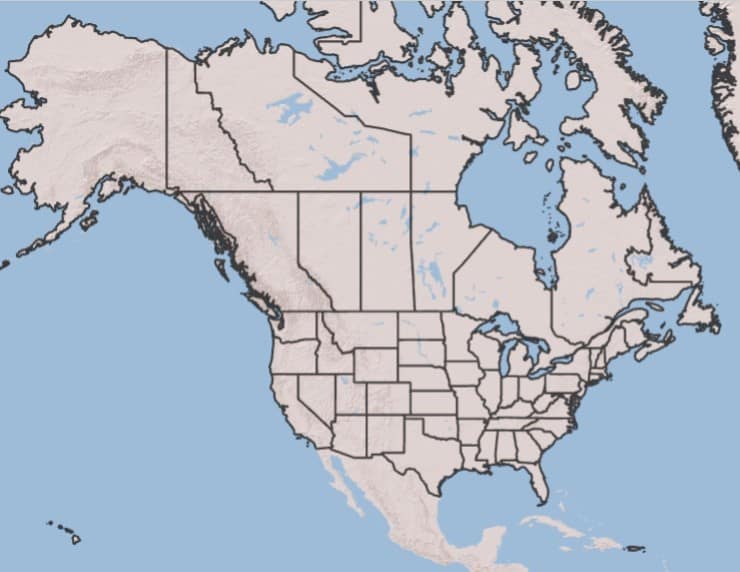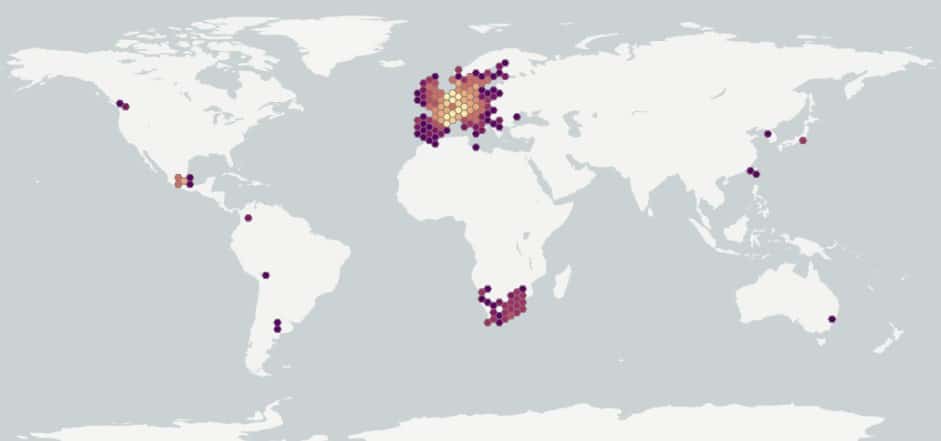Senecio inaequidens
Overview
Aperçu
Regulation :
Remarques Réglementation:
- CFIA Weed Seeds Order - Class 1: Prohibited Noxious Weed Seeds
- List of Pests Regulated by Canada
- USA Federal Noxious Weed List
- USA Federal Noxious Weed Seed List
Regulation Notes:
Prohibited Noxious, Class 1 in the Canadian Weed Seeds Order (2016) under the Seeds Act. All imported and domestic seed must be free of Prohibited Noxious weed seeds.
Distribution :
Répartition :
Native to southern Africa and introduced to many European countries and Taiwan (CABI 2020). Reports from Mexico and parts of South America may refer to Senecio madagascariensis (Rzedowsky et al. 2003; CFIA 2012). Absent from Canada (Brouillet et al. 2010+).
Habitat and Crop Association :
Habitat et Cultures Associées :
Colonizes a wide range of open ruderal habitats, including vineyards, logged forests, rocky outcrops and coastal dunes but appears to prefer disturbed, well-drained soils (CABI 2020).
Economic Use, cultivation area, and Weed Association :
Utilisation économique, zone de culture et association de mauvaises herbes :
Duration of Life Cycle :
Durée du cycle vital:
Perennial
Dispersal Unit Type :
Type d’unité de dispersion :
Achene
General Information
RENSEIGNEMENTS GÉNÉRAUX
Historic introduction sites of S. inaequidens in Europe were closely tied with the wool industry (CABI 2020). Pastures that contain S. inaequidens produce lower quality forage due to the poisonous alkaloids in the plant (Dimande et al. 2007).
This species produces thousands of seeds per year that can be carried by water, hay, humans or machinery into new habitats (Heger and Böhmer 2006; CABI 2020).
.Identification
Identification
-
Achene
Size
- Achene length*: 2.7 – 3.1 mm; width: 0.3 – 0.5 mm
*Note: minimum and maximum of 10 achenes in a normal range of this species using image measurement (ISMA 2020)
Shape
- Cylindrical achene, slightly curved or sometimes straight with one narrowed end or both ends wide
Surface Texture
- Surface is stippled, with several longitudinal ribs
- Dense, short white hairs between and sometimes on the ribs
Colour
- Achene shiny brown or dark brown, appears dull grey due to the dense hairs on the surface
- Achenes may be greenish coloured when immature
Other Features
Pappus
- Immature achenes have a long, white pappus 2-3 times the length of the achene (CABI 2020)
- Pappus is easily detached from mature achenes (CABI 2020)
Pappus end
- A small, thin style remnant is in the center of pappus end
- A thick ring of white tissue is at the pappus end
Opposite end
- Generally more narrow than the pappus end
- A stalk is in the centre of this end, thinner than the style remnant at the pappus end
- Thin ring of white tissue is on the end opposite the pappus
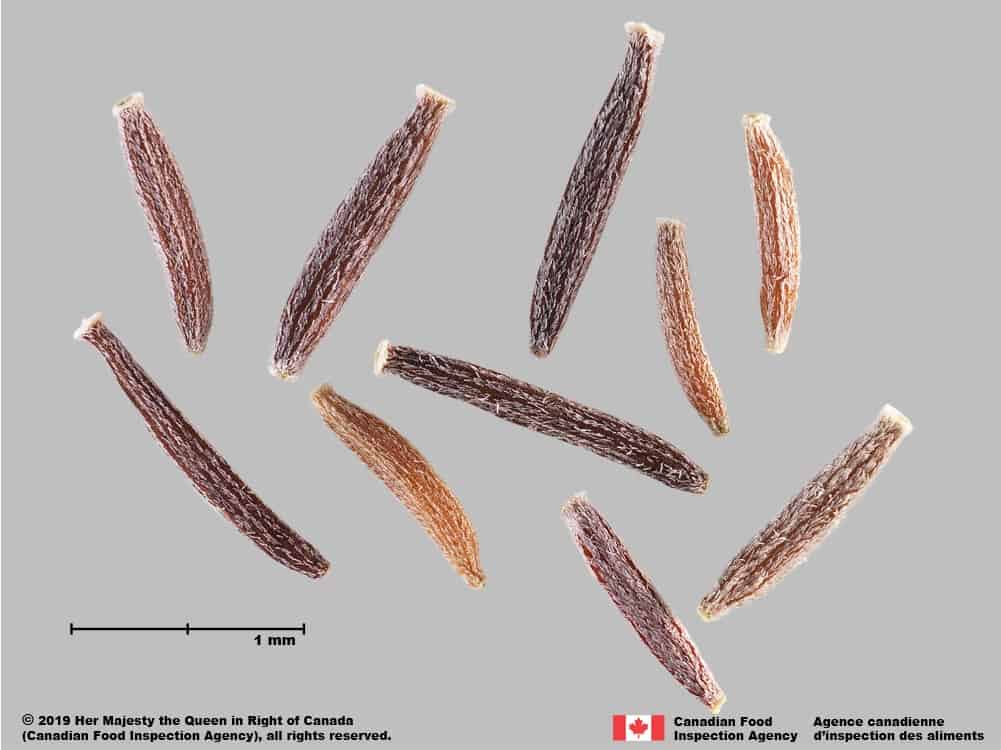
South African ragwort (Senecio inaequidens) achenes

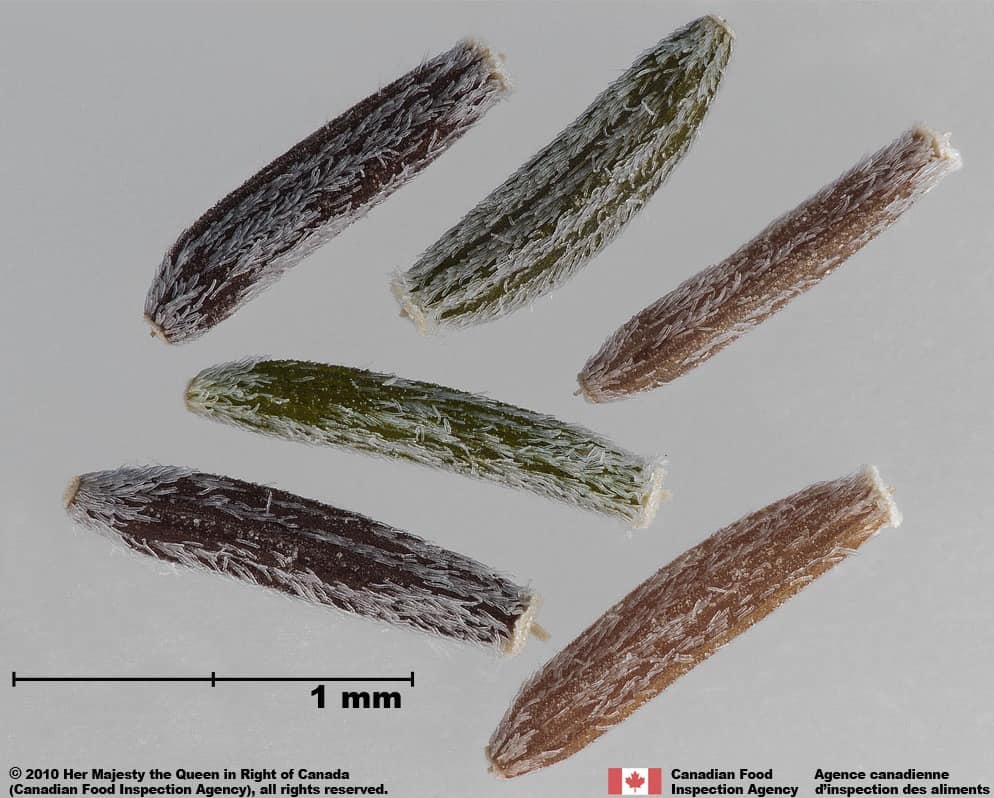
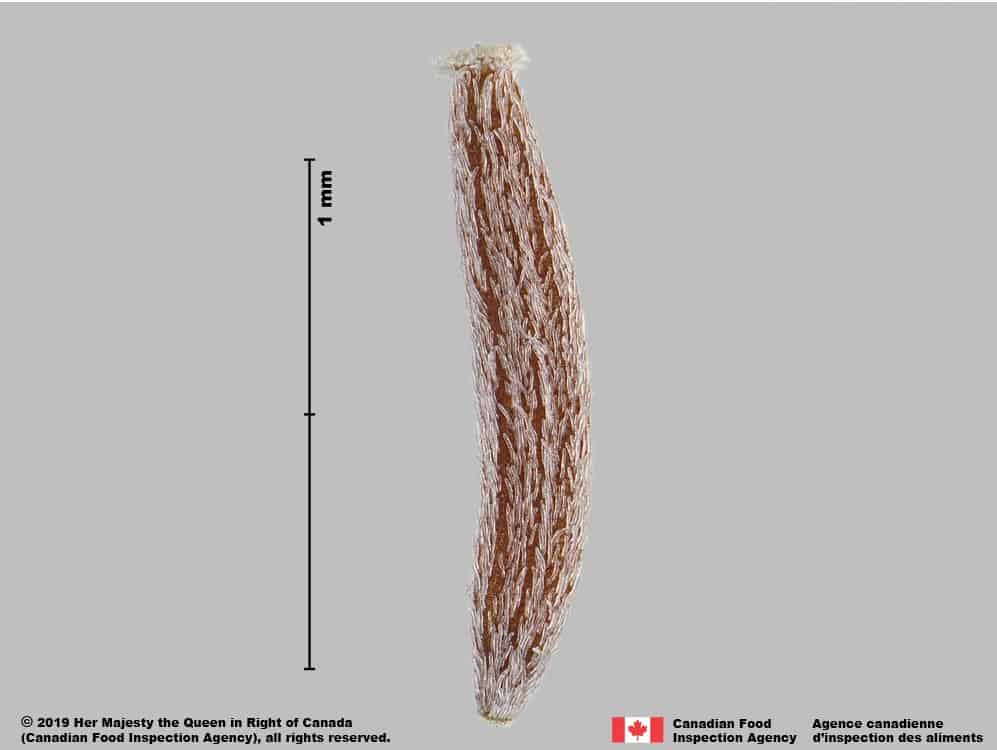
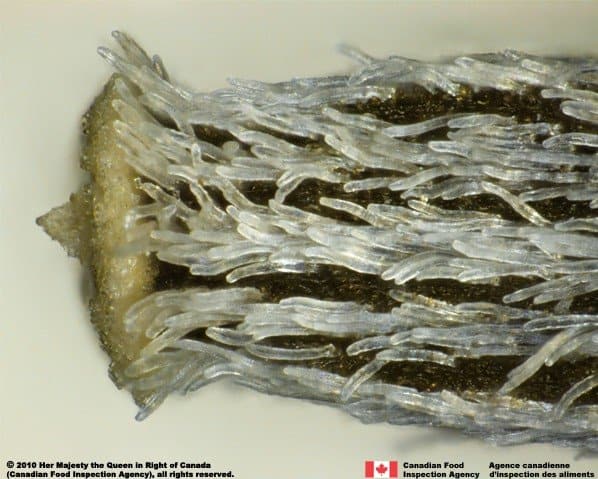
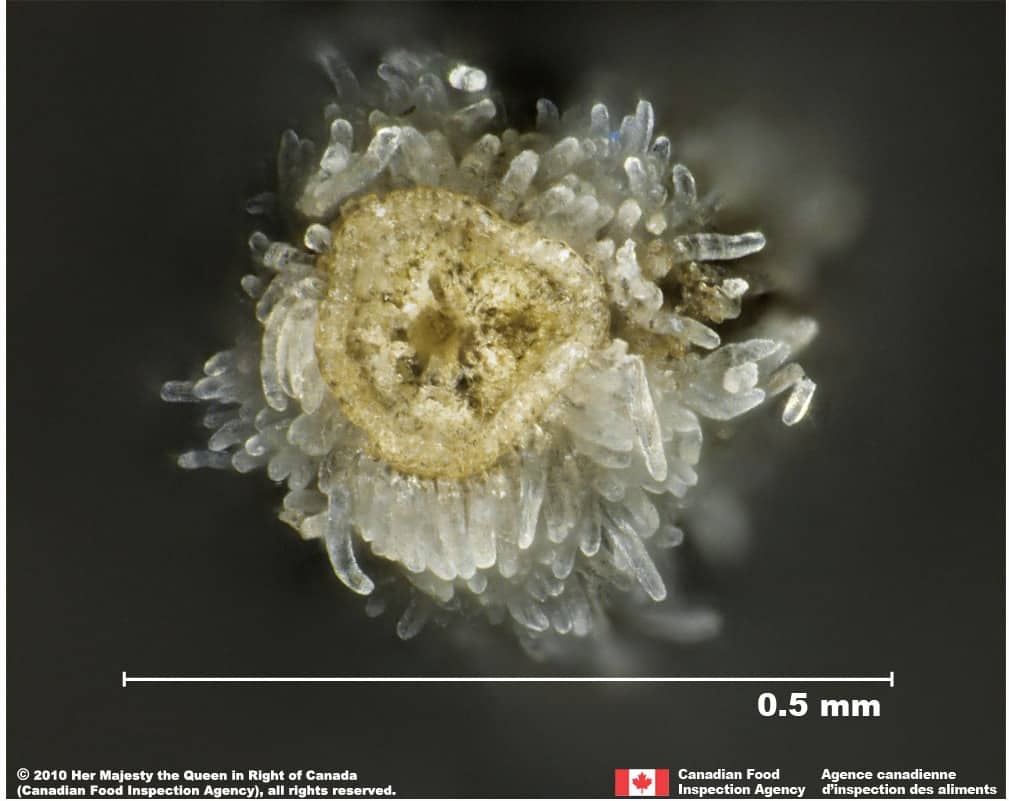
-
Seed
Size
- Seed fills the achene
Shape
- Seed is oblong shaped
Surface Texture
- Seed surface is smooth
Colour
- Seed grey coloured
Other Features
- Seed coat thin, whitish coloured, adhering to the fruit wall
-
Embryo
Size
- Embryo fills the seed
Shape
- Embryo is spatulate, axial position
Endosperm
- Endosperm absent, nutritive tissue stored in the cotyledons
Other Features
- Cotyledons are soft-textured
Identification Tips
CONSEILS POUR L’IDENTIFICATION
The dense surface hairs, both achene ends with white tissue and one narrow end (sometimes both are wide) of S. inaequidens achenes distinguishes this species from similar Senecio species.

South African ragwort (Senecio inaequidens) achene, close-up of surface





Additional Botany Information
AUTRES RENSEIGNEMENTS BOTANIQUES
Flowers/Inflorescence
- Flowers yellow, daisy-like with both disc and ray florets (CABI 2020)
Similar Species
ESPÈCES SEMBLABLES
Similar species are based on a study of seed morphology of various species, and those with similar dispersal units are identified. The study is limited by physical specimen and literature availability at the time of examination, and possibly impacted by the subjectivity of the authors based on their knowledge and experience. Providing similar species information for seed identification is to make users aware of similarities that could possibly result in misidentification.
Senecio vulgaris L. (common groundsel)
S. vulgaris achenes are generally smaller and wider (length*: 1.9 – 2.7 mm; width: 0.4 – 0.6 mm), narrowed at both ends, while S. inaequidens is narrowed at one end or wide at both ends. Only one end has a ring of white tissue compared to S. inaequidens achenes which have two. The surface hairs of S. vulgaris are short and sparse, the hairs of S. inaequidens are longer and more dense.
Senecio madagascariensis Poir. (Madagascar ragwort)
S. madagascariensis achenes are generally shorter than S. inaequidens (length* 1.7 – 2.1 mm; width: 0.4 – 0.5 mm), both ends of achenes are narrow, usually reddish brown coloured with short white hairs between the ribs, S. inaequidens achenes are generally darker with longer hairs.
*Note: minimum and maximum of 10 achenes in a normal range of this species using image measurement (ISMA 2020)
Click to select species
Cliquez pour sélectionner les espèces
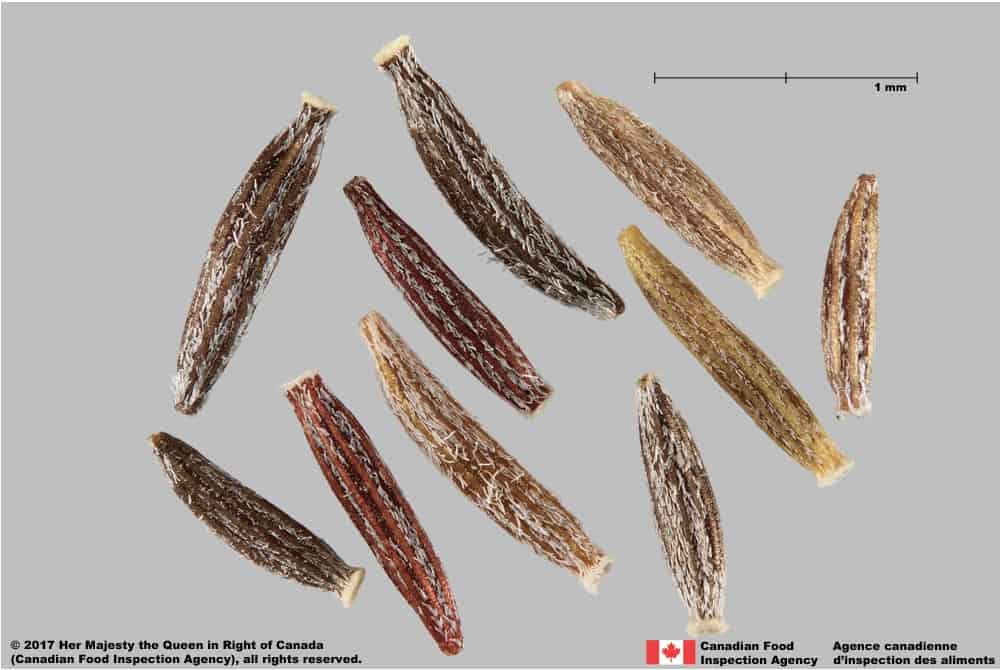
Senecio vulgaris
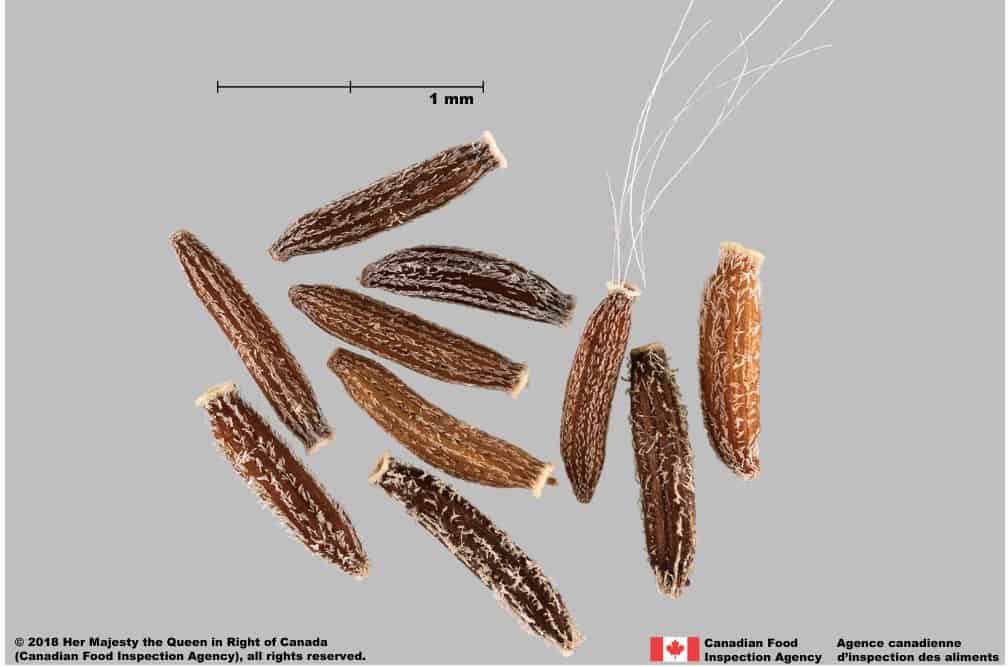
Senecio madagascariensis
Comparison Window
Fenêtre de comparaison
MAIN SPECIES
ESPÈCES PRINCIPALES
Senecio inaequidens

Senecio inaequidens
Asteraceae
South African ragwort (Senecio inaequidens) achenes
MAIN SPECIES
ESPÈCES PRINCIPALES
Senecio inaequidens

Senecio inaequidens
Asteraceae
South African ragwort (Senecio inaequidens) achenes
MAIN SPECIES
ESPÈCES PRINCIPALES
Senecio inaequidens

Senecio inaequidens
Asteraceae
South African ragwort (Senecio inaequidens) achene
MAIN SPECIES
ESPÈCES PRINCIPALES
Senecio inaequidens

Senecio inaequidens
Asteraceae
South African ragwort (Senecio inaequidens) achene, close-up of surface
MAIN SPECIES
ESPÈCES PRINCIPALES
Senecio inaequidens

Senecio inaequidens
Asteraceae
South African ragwort (Senecio inaequidens) achene; end opposite pappus
SIMILAR SPECIES
ESPÈCES SEMBLABLES
Senecio vulgaris

Senecio vulgaris
Asteraceae
Common groundsel (Senecio vulgaris) achenes
SIMILAR SPECIES
ESPÈCES SEMBLABLES
Senecio vulgaris
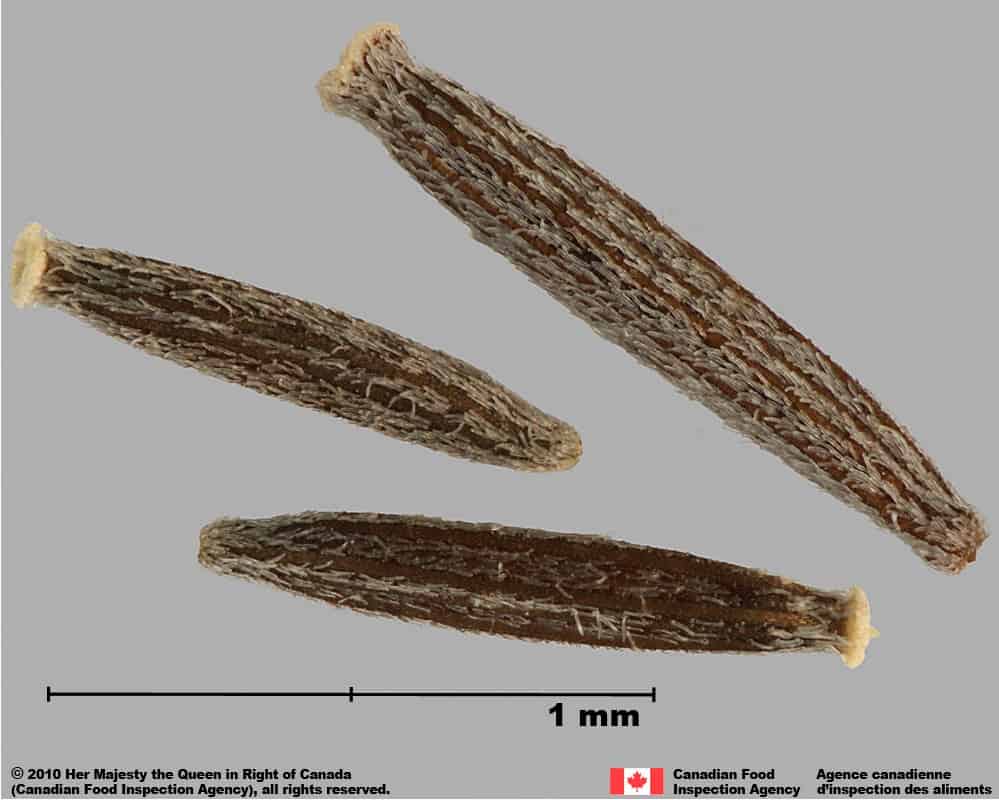
Senecio vulgaris
Asteraceae
Common groundsel (Senecio vulgaris) achenes
SIMILAR SPECIES
ESPÈCES SEMBLABLES
Senecio vulgaris
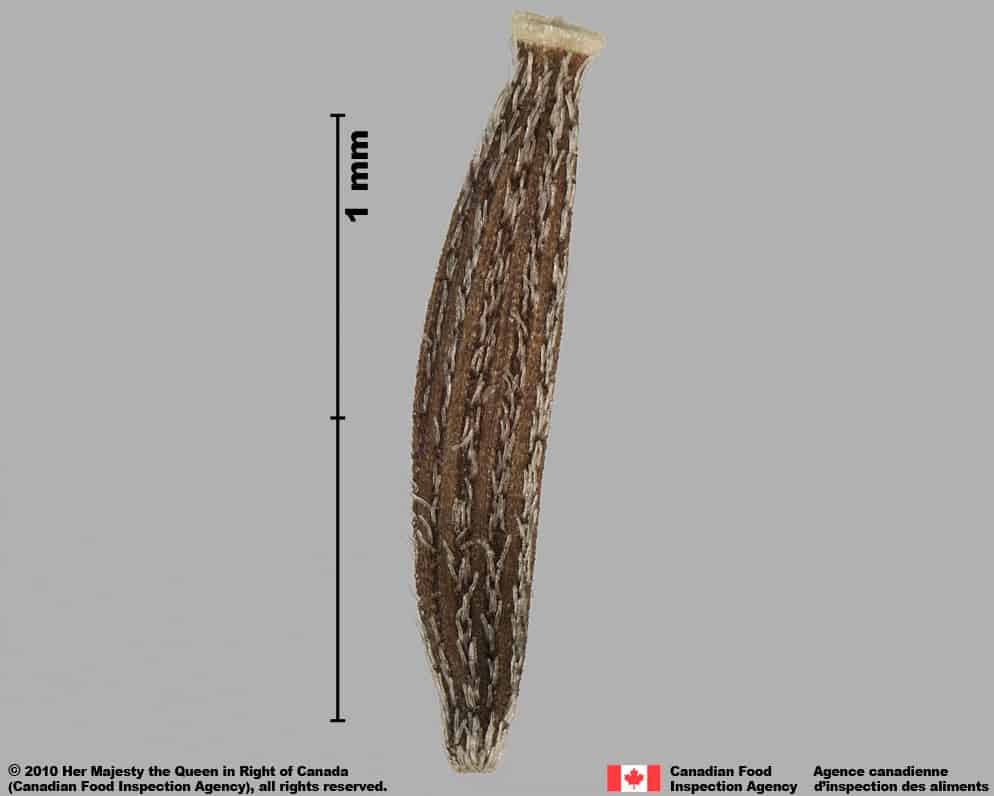
Senecio vulgaris
Asteraceae
Common groundsel (Senecio vulgaris) achene
Need ID Help?
Besoin d’aide pour l’identification?
Reference(s)
Référence(s)
Brouillet, L., Coursol, F., Meades, S. J., Favreau, M., Anions, M., Bélisle, P. and Desmet, P. 2010+. VASCAN, the database of vascular plants of Canada. http://data.canadensys.net/vascan/ Accessed November 24, 2020.
Centre for Agriculture and Bioscience International (CABI). 2020. Invasive Species Compendium, CAB International, Wallingford, UK. https://www.cabidigitallibrary.org/journal/cabicompendium Accessed November 24, 2020.
Dimande, A. F. P., Botha, C. J., Prozesky, L., Bekker, L., Rosemann, G. M., Lasbuschagne, L. and Retief, E. 2007. The toxicity of Senecio inaequidens DC. Journal of the South African Veterinary Association 78: 121-129.
Heger, T. and Böhmer, H. J. 2006. NOBANIS – Invasive Alien Species Fact Sheet – Senecio inaequidens. Online database of the North European and Baltic Network on Invasive Alien Species, www.nobanis.org Accessed May 30, 2016.
Global Biodiversity Information Facility (GBIF) Secretariat. 2022. https://doi.org/10.15468/39omei Accessed via https://www.gbif.org/species/3109086 Accessed December 29, 2022.
Government of Canada (GC). 2016. Canadian Weed Seeds Order. https://laws-lois.justice.gc.ca/eng/regulations/SOR-2016-93/page-2.html (English) https://laws-lois.justice.gc.ca/fra/reglements/DORS-2016-93/page-2.html (French)
International Seed Morphology Association (ISMA). 2020. Method for Seed Size Measurement. Version 1.0. ISMA Publication Guide. https://www.idseed.org/authors/details/method_for_seed_size_measurement.html
Rzedowsky, J., Vibrans, H. and Calderón de Rzedowsky, G. 2003. Senecio inaequidens DC. (Compositae, Senecioneae), una maleza perjudicial introducida en México. Acta Botanica Mexicana 63: 83-96.
U.S. Department of Agriculture-Natural Resources Conservation Service (USDA-NRCS). 2022. The PLANTS Database. National Plant Data Team, Greensboro, NC USA. http://plants.usda.gov Accessed December 29, 2022.



